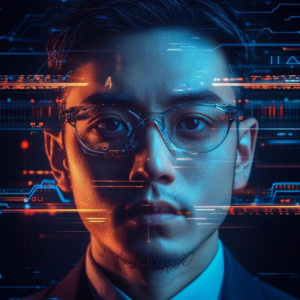1. Introduction
In today’s rapidly evolving digital landscape, artificial intelligence (AI) has become one of the most transformative forces in the tech industry. I have witnessed firsthand how AI is not only shaping our devices but also revolutionizing the way we interact with technology. In this comprehensive guide, I will delve into the trends and innovations that are redefining tech, share personal insights, and provide practical examples on how AI is altering every facet of our lives. This is a prime example of AI revolutionizing tech, as it continuously reshapes our understanding of technology. Whether you’re a tech enthusiast or a professional seeking to stay ahead of the curve, this article will equip you with valuable knowledge about the AI revolution and its far-reaching impact. I invite you to join me on this journey as we explore the past, present, and future of AI in tech.

2. The Rise of Artificial Intelligence in Tech
2.1 From Theory to Reality
Over the past decade, artificial intelligence has transitioned from theoretical concepts confined to academic research to practical, real-world applications. I remember when AI was a niche topic discussed only among experts. Today, AI is revolutionizing tech by integrating into everyday devices and systems—proving that AI revolutionizing tech is not just a catchphrase but a reality.
2.2 Key Enablers of AI Growth
Several factors have driven this remarkable evolution:
- Big Data: The explosion of digital data provides the raw material for AI to learn and improve continuously.
- Advanced Algorithms: Innovations in machine learning and deep learning have unlocked AI’s potential to solve complex problems.
- Cloud Computing: Scalable platforms now make it possible to process and analyze massive datasets efficiently.
These key enablers are at the heart of AI revolutionizing tech, making it possible for companies to develop smarter, more efficient solutions.
2.3 Industry-Wide Integration
AI’s influence is not limited to one sector—it spans across healthcare, automotive, finance, and consumer technology. For example, smart assistants like Siri and Alexa leverage AI to understand natural language and provide personalized experiences, while recommendation systems on streaming platforms suggest content based on user behavior. This broad integration is a clear demonstration of how AI revolutionizing tech is reshaping our interactions with technology on a daily basis.
2.4 Looking to the Future
Recent breakthroughs in reinforcement learning and the merging of AI with emerging technologies such as the Internet of Things (IoT) and blockchain are opening up new avenues for innovation. These advances indicate that AI revolutionizing tech is not static; it continues to evolve and drive a paradigm shift in how we approach problem-solving and innovation. As these trends progress, the potential for further transformative change remains immense.
In summary, the dynamic evolution of artificial intelligence—through research breakthroughs, enabling technologies, and its expansive integration across industries—confirms that AI revolutionizing tech is a driving force for the future.
3. AI’s Impact on Various Sectors
3.1 Smartphones
AI is making smartphones smarter. Modern devices use AI for facial recognition, adaptive camera settings, and responsive voice assistants. These enhancements create a more intuitive user experience without complicating the interface.
3.2 Computers and Hardware
AI is streamlining computer performance. It helps optimize processing speeds, manage power consumption, and even predict hardware issues before they occur. This integration makes computers more efficient and user-friendly.
3.3 Smart Home and IoT
AI brings convenience to smart homes. Devices like thermostats, security cameras, and lighting systems learn from your habits to create a personalized environment. In the broader IoT landscape, AI improves urban services and sustainability with minimal effort.
3.4 Software and Mobile Apps
AI transforms software by personalizing user experiences. It powers features like predictive text, tailored recommendations, and seamless language translation. These improvements make apps more engaging and easier to use.
4. Emerging Trends and Future Innovations
4.1 AI and Machine Learning Breakthroughs
Every day, I am amazed by the pace at which AI and machine learning (ML) technologies are evolving. From advanced neural networks to sophisticated natural language processing models, the breakthroughs in this field are reshaping the boundaries of what machines can do. One of the most exciting developments is the rise of generative AI, which is enabling machines to create art, music, and even complex narratives that mimic human creativity. Companies across the globe are investing heavily in AI research and development, and the implications are enormous. These innovations are not just confined to theoretical research; they are being rapidly commercialized to solve real-world problems—from automating routine tasks to enabling highly personalized user experiences. I highly recommend watching this insightful TED Talk on AI Innovations: Watch TED Talk on AI Innovations as it provides a compelling visual and detailed explanation of these breakthrough technologies. It is evident that advances in AI revolutionizing tech have fueled unprecedented breakthroughs in machine learning.

4.2 AI in Cybersecurity
As our reliance on technology grows, so does the importance of robust cybersecurity. AI is playing a crucial role in this arena by enhancing our ability to detect and respond to threats in real time. Modern cybersecurity systems use AI to analyze patterns in data, identify anomalies, and predict potential breaches before they occur. I have seen organizations implement AI-driven security platforms that continuously monitor network traffic and user behavior, enabling them to identify vulnerabilities that might otherwise go unnoticed. This proactive approach is essential in an era where cyber-attacks are becoming increasingly sophisticated. AI-powered systems not only reduce the time taken to respond to incidents but also learn from past events, continuously refining their threat-detection capabilities. Furthermore, the integration of AI in cybersecurity has led to the development of advanced biometric authentication methods, which provide an additional layer of security by verifying user identity through facial recognition or fingerprint analysis. By relying on real-time data and predictive analytics, these systems help create a more secure digital environment, protecting sensitive information and maintaining trust in digital infrastructures. Integrating AI revolutionizing tech into cybersecurity solutions has significantly improved threat detection. For more detailed insights into the intersection of AI and cybersecurity, I recommend exploring resources provided by the National Institute of Standards and Technology (NIST), which offers guidelines and best practices that are highly regarded worldwide.
4.3 Autonomous Systems and Robotics
The realm of autonomous systems and robotics has also been significantly impacted by AI. Self-driving cars, delivery drones, and robotic assistants are just a few examples of how AI is transforming transportation and logistics. These systems rely on a combination of sensors, real-time data processing, and advanced algorithms to navigate complex environments without human intervention. I have followed the progress of several companies that are pioneering the use of AI in robotics, and it is fascinating to observe how these systems are improving efficiency, safety, and operational reliability. For instance, autonomous delivery drones are already being tested in urban areas, where they promise to reduce delivery times and lower carbon emissions. Similarly, self-driving cars are poised to revolutionize the automotive industry by enhancing road safety and reducing traffic congestion through optimized route planning and predictive maintenance. As these technologies mature, they will not only streamline logistics but also redefine our relationship with transportation. The potential of AI revolutionizing tech extends beyond commercial applications; these innovations are increasingly being used in sectors like healthcare, where robotic assistants are helping in surgeries and patient care, demonstrating the versatility and transformative impact of AI in robotics.
5. Case Studies: How Companies Are Leveraging AI
To truly understand the transformative power of AI, it’s essential to look at real-world examples of how companies are leveraging this technology. I have closely followed several success stories in the tech industry, and these case studies serve as a testament to AI’s potential. For instance, tech giants like Google and Microsoft are investing billions of dollars in AI research, using their vast resources to develop innovative products and services. Google’s AI-driven search algorithms and personalized recommendations have fundamentally changed the way we access information online, while Microsoft’s integration of AI into its suite of productivity tools has enhanced real-time collaboration and predictive analytics for millions of users worldwide. Startups are also making waves by harnessing the power of AI to disrupt traditional industries. Companies specializing in computer vision, natural language processing, and robotics are creating solutions that solve complex challenges—from automating customer service with intelligent chatbots to optimizing supply chains through advanced predictive modeling. I have personally witnessed how such innovations not only boost operational efficiency but also open up entirely new revenue streams, encouraging further investment in AI research and development. These case studies are clear indicators of AI revolutionizing tech across industries. If you’re interested in learning more about cutting-edge tech innovations, don’t miss our article on How to Build a High-Performance Custom PC, which dives deep into the hardware innovations that are driving these advancements.
6. Challenges and Ethical Considerations in AI
Despite its vast potential, AI also poses significant challenges and ethical dilemmas that must be addressed. As someone who has spent years researching and working in tech, I recognize that the rapid pace of AI innovation brings with it concerns about privacy, bias, and accountability. One major challenge is the risk of algorithmic bias. Since AI systems learn from historical data, they can inadvertently perpetuate existing social biases if not properly managed. This has led to increased scrutiny from regulators and calls for more transparent and ethical AI practices. Privacy is another critical issue. With AI systems processing massive amounts of personal data, safeguarding user privacy has become a top priority. Robust data protection measures and clear regulatory frameworks are essential to build trust and ensure that AI is used responsibly. I have also noticed that discussions around ethical AI are becoming more prominent in both academic and industrial circles. Many experts advocate for the inclusion of ethics boards and review committees to oversee AI development, ensuring that systems are designed with fairness and accountability in mind. These conversations are crucial not only for mitigating risks but also for fostering public trust in AI technologies. Addressing these challenges is part of AI revolutionizing tech in a responsible manner.
7. Integrating AI in Everyday Life: Practical Applications
Artificial intelligence is not limited to high-tech labs or corporate boardrooms—it is increasingly becoming a part of our daily routines. From personalized shopping experiences to smart home automation, AI is integrated into many aspects of everyday life. Consider the smart assistants on your smartphone; these devices use AI to interpret your voice commands, set reminders, and even manage your schedule. I often rely on these features to streamline my daily tasks, making life both easier and more efficient. Another practical application is in the realm of healthcare, where AI-powered diagnostic tools are helping doctors detect diseases earlier and with greater accuracy. Retailers use AI to provide tailored product recommendations based on your browsing history, ensuring that you see the most relevant options. Financial institutions are leveraging AI to offer personalized banking experiences and fraud detection services, enhancing security and user satisfaction. These applications of AI not only improve convenience but also contribute to significant cost savings and enhanced performance in various industries. By incorporating AI into everyday tasks, technology is seamlessly bridging the gap between innovation and practicality, transforming the way we live and work. It is clear that AI revolutionizing tech is making everyday applications more efficient and personalized. For readers interested in diving deeper into these practical applications, our In-Depth Review: The Latest Flagship Smartphones offers additional insights into how AI is enhancing mobile technology.

8. How to Stay Ahead: Adapting to the AI Revolution
Keeping pace with the rapid evolution of AI requires continuous learning and adaptation. In my journey through the tech world, I have discovered that staying informed is the key to leveraging AI effectively. Continuous education is essential; I dedicate time to learning about the latest AI developments through online courses, webinars, and industry conferences. Following thought leaders on platforms like LinkedIn and Twitter has proven invaluable for gaining insights into emerging trends and best practices. Experimenting with new AI-powered tools and applications is another strategy I recommend. This hands-on approach not only deepens your understanding of AI capabilities but also sparks innovation by encouraging you to think outside the box. Networking with professionals in the tech industry is equally important, as it allows for the exchange of ideas and experiences that can lead to collaborative solutions. I make it a point to attend tech meetups and participate in online forums where experts share their knowledge and insights about the evolving AI landscape. By integrating these practices into your routine, you can stay ahead of the curve and position yourself to take full advantage of the opportunities presented by AI. Staying updated on AI revolutionizing tech is essential for leveraging new opportunities in this fast-paced industry.
9. Conclusion
In conclusion, artificial intelligence is fundamentally transforming the tech industry, paving the way for innovations that are enhancing our daily lives and revolutionizing how we interact with technology. From smarter smartphones and computers to advanced applications in cybersecurity and robotics, AI’s influence is both profound and far-reaching. Throughout this article, I have shared insights on the evolution of AI, its impact on various sectors, and the emerging trends that will shape the future of tech. I believe that embracing AI’s potential—while remaining vigilant about its ethical and practical challenges—will be key to unlocking a smarter, more connected future. Ultimately, AI revolutionizing tech holds the promise of a transformative future. The journey of AI revolutionizing tech continues to inspire innovation and drive progress in every field.
10. Frequently Asked Questions (FAQ)
Q1: What makes AI so transformative in the tech industry?
A1: AI’s ability to analyze vast amounts of data, learn from patterns, and make real-time decisions makes it a powerful tool for enhancing efficiency, personalizing user experiences, and driving innovation across various tech sectors.
Q2: How is AI improving smartphone technology?
A2: AI enhances smartphones by optimizing camera settings, enabling facial recognition, and powering virtual assistants that understand natural language, thereby improving both functionality and user experience.
Q3: What are some practical applications of AI in everyday life?
A3: Everyday applications of AI include smart home automation, personalized recommendations in shopping and entertainment, AI-powered healthcare diagnostics, and virtual assistants that help manage daily tasks.
Q4: Are there ethical concerns associated with AI?
A4: Yes, ethical concerns such as algorithmic bias, data privacy, and accountability are major issues that need to be addressed through responsible AI development and regulatory frameworks.
For those interested in advanced technology, I have a tool that has helped me a lot in creating the right prompts to generate amazing images. Check out the best AI for creating images and videos here.
